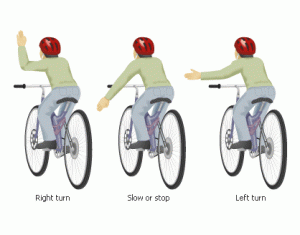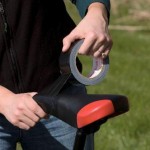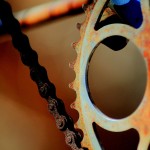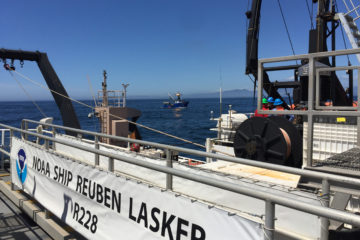Ocean Companies Safety Tip of the Week – Bicycle Safety
SAFE (AND SANE?) BICYCLING
As I was sitting at my desk trying to figure out a topic for this week, we had one of our fleeting five minute sun breaks and bicycling came to mind. As I started my research for the article, I remembered driving home from Aberdeen one night in late February, and as usual, it was dark and rainy out. We were approaching the Elk River Bridge as a car crested the top of the bridge coming in the opposite direction. If it hadn’t been for that car, we would not have seen the person riding a bicycle halfway up the bridge and dressed in all black with no reflectors or bright clothing. He did, however, shine a very small flash light behind him a couple times after the other car had passed and our hearts were racing. That memory clenched my resolve to write this article.
It is spring, no matter what the weather tells us, and eventually we will be able to get outside and do some biking. Don’t wait for the sunshine to get your bike and accessories ready for that first ride of the season. Keeping your bike and bike riding equipment in top working condition and fitting properly will make your rides safer and more enjoyable.
 GET THE RIDER READY: Many cities and counties have passed laws that all ages of bicyclists must wear helmets. Aberdeen, Washington passed the law in 2001 and they enforce it. A bike helmet reduces the risk of head injuries by as much as 85 percent in case of an accident. Make sure the bike helmet is neither too loose, nor too tight. Children should have their helmets refitted each year as they grow. You should also replace a helmet that has been damaged in any way. Cracks or scratches in the helmet’s surface will reduce the amount of protection it will provide.
GET THE RIDER READY: Many cities and counties have passed laws that all ages of bicyclists must wear helmets. Aberdeen, Washington passed the law in 2001 and they enforce it. A bike helmet reduces the risk of head injuries by as much as 85 percent in case of an accident. Make sure the bike helmet is neither too loose, nor too tight. Children should have their helmets refitted each year as they grow. You should also replace a helmet that has been damaged in any way. Cracks or scratches in the helmet’s surface will reduce the amount of protection it will provide.
Avoid baggy clothing that may get caught in the chain, gears, or spokes and cause a painful crash. Even baggy shorts and shirts can put you in danger. If your pants have wide legs, use a large rubber band, a boot blouse, or pant leg bands to keep your pants from being pulled into the bike’s mechanisms.
Wear bright clothing, preferably with reflective tape on it. This is good for visibility during both day and night riding. You can pick up fluorescent orange vests with reflective tape at most sporting goods stores. Sometimes you leave the house fully intending on returning home in the daylight, only to get distracted and get home way after dark. Now having said that, I confess to having used a white plastic bag attached to my coat in the past so I would be visible at night.
 Know your hand signals. They are the same signals you would use in your car. To turn right, raise your left arm straight out from your shoulder and bent towards the sky at the elbow. To turn left, bring your left arm parallel to the ground, straight out from the shoulder. To slow or stop, raise your left arm straight out from your shoulder and bend it at the elbow towards the ground.
Know your hand signals. They are the same signals you would use in your car. To turn right, raise your left arm straight out from your shoulder and bent towards the sky at the elbow. To turn left, bring your left arm parallel to the ground, straight out from the shoulder. To slow or stop, raise your left arm straight out from your shoulder and bend it at the elbow towards the ground.
GET THE BIKE TUNED UP: If you are getting a child’s bike ready for riding, have the child stand straddling the bar in front of the seat. It should be 2 to 4 inches below the child. DO NOT buy a bike taller knowing they will grow into it. A bike that is too tall can be hard to handle and increase possible injuries in a crash, while a bike that is too small is harder to control.
 Checking the adjustment of the seat is something everyone needs to do. While sitting on the seat, check to make sure the height and position enable the rider to pedal without any trouble. Make sure after adjusting the seat that it is secured so it won’t slip down or swivel side to side. If the seat is worn out and the padding is showing, you can repair it or purchase a new seat and replace it easily.
Checking the adjustment of the seat is something everyone needs to do. While sitting on the seat, check to make sure the height and position enable the rider to pedal without any trouble. Make sure after adjusting the seat that it is secured so it won’t slip down or swivel side to side. If the seat is worn out and the padding is showing, you can repair it or purchase a new seat and replace it easily.
Test your brakes every time you get on the bike. The bicycle should come to a stop using only moderate pressure. Sometimes they will just need to be adjusted, but they may be worn out and need replacing.
If the tubes are flat, riding the bike can damage the tire and/or the rim. Make sure your tires are adequately inflated. Just as a car’s tire can affect your car’s performance a bike will perform better with proper inflation. Each tire has its own optimum air pressure, but after some research, I found the amount of pressure changes with a heavier rider, so I would advise you find out what is best from your tire manufacture.
The spokes of a bike are there to add strength to the rim, transfer your leg power from the hub to the wheel, and to support your weight on the wheel. It is important to make sure there are no bent or broken spokes and when you run your fingers over them in a firm manner, they should make a twanging noise. Replace or tighten any that are not in good shape or your rim may be off balance and cause other spokes to fail.
 If your chain has any broken links, or is rusted, it is best to replace it. If the chain is in good condition, it should be tight with adequate tension. A chain may be the single most important part of the bike. Without it, you just have a big push toy.
If your chain has any broken links, or is rusted, it is best to replace it. If the chain is in good condition, it should be tight with adequate tension. A chain may be the single most important part of the bike. Without it, you just have a big push toy.
Your pedals should be securely attached and spin easily and should not slide around on the pedal bar.
THINGS TO ADD TO YOUR BIKE FOR SAFETY:
- Washington State law requires “either a red light or a high quality red reflector (visible up to 300 feet from behind)” attached to the back of the bike when riding at night.
- Washington State law requires a “white headlight (visible at least 500 feet ahead)” when riding at night.
- A mirror will help you see traffic coming from behind you and make you feel more secure.
KNOW THE RULES: In Washington, bicycles are legally considered “vehicles” and must obey the rules of the road (e.g. signs, signals, speed limits, and lane markings). I remember coming down a long hill when my brother and I were teenagers and my brother getting a speeding ticket for doing 45 mph in a 35 mph zone.
The following are some safety tips from the Washington State Department of Transportation (WSDOT):
- Obey all traffic signs and signals.
- Always ride with traffic, never against.
- Follow lane markings – Don’t turn left from the right lane and don’t go straight from a “right turn only”.
- Choose the best way to turn left: either like an auto where you move into the left turn lane, signal, and turn left; or like a pedestrian where you ride to the crosswalk and walk your bike across.
- Don’t pass on the right. You’re smaller than a car and harder for them to see.
- Keep an eye on the road behind you, either carefully looking over your shoulder, or using a mirror.
- Always be prepared to brake with both hands. A one-handed brake may cause an accident.
- Always wear your helmet
- NEVER wear headphones while riding a bike!! You need to be able to hear the traffic around you!
- Dress for the weather. If you must wear rain gear or a poncho, make sure it won’t get caught in the bikes moving parts. Wear layers of clothing so you can adjust as you need to, and be sure to wear bright colors.
- Use hand signals, as a matter of law, courtesy and self-protection.
- Make eye contact with drivers. Assume they don’t see you until you are sure that they do!
- Watch for road hazards like sewer grates, gravel, ice, sand, debris railroad track and parked cars with people in them. They just may open a door in your path you could crash into.
- Use your lights at night. It’s the law!
Washington is one of the top bicycle friendly states in the country by being a leader in our efforts to improve conditions for cyclists. There are literally thousands of miles of bike trails and routes in our state and you can find out where by going to www.wsdot.wa.gov/bike/statemap.htm. Bicycling is a fun way to get exercise and to battle the soaring gas prices, but be sure you have everything in place to do it safely.
Sources: WSDOT, BicycleSafe, livestrong
– Cherie


